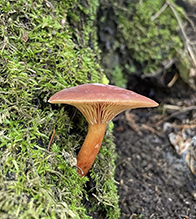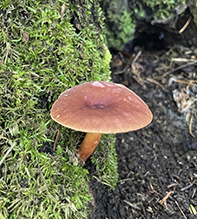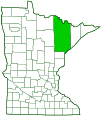milkcap
(Lactarius fragilis)
Conservation • Description • Habitat • Ecology • Distribution • Taxonomy
Conservation Status |
|
|||||||
| IUCN Red List | not listed |
|||||||
| NatureServe | not listed |
|||||||
| Minnesota | not listed |
|||||||
Description |
||
Lactarius fragilis is a small to medium-sized, gilled mushroom. In the United States it occurs in the southeast and on the west coast, and there are a few scattered records in the Midwest. It is found in spring, summer, and fall, alone, scattered, or in groups but not clustered (gregarious). It grows on the ground attached to the roots of both hardwood and conifer trees. It has a mutually beneficial relationship (mycorrhizal) with the tiny rootlets of trees, absorbing sugars and amino acids while helping the tree absorb water. When it first appears, the cap is convex and dark reddish-brown. The upper surface may be moist or dry and is sometimes covered with a fine dust-like powder. There is sometimes a raised, knob-like point in the middle (umbonate). As it ages the cap expands and the color fades. The mature cap is ¾″ to 2¾″ (2 to 7 cm) in diameter, broadly convex on top but flat below (plano-convex), and depressed in the center. The upper surface is light reddish-brown to light brown, darker in the center, paler near the margin. The margin is sometimes scalloped or lined on older specimens. The gills are closely spaced or crowded, and are broadly attached to the stalk, sometimes slightly running down the stalk. They are yellowish at first, becoming the same color as the cap with age. The stalk is hollow, fragile, ¾″ to 3½″ (2 to 9 cm) long, and ⅛″ to ⅝″ (4 to 15 mm) thick, more or less the same thickness from top to bottom. It is the same color as the cap but becomes paler near the top with age. It is mostly smooth but may have hairs near the base. It does not have “potholes”. A fresh mushroom will exude a watery white (whey-like) latex when sliced. This is best seen by slicing the gills near the stalk. The flesh is hard, brittle, and pale cinnamon to white. It has a strong maple-like odor when fresh, and the odor persists when it is dried. It is edible, but it closely resembles other species whose edibility is unknown. The spore print is pale yellow or whitish. |
||
Similar Species |
||
Habitat and Hosts |
||
Hardwood and conifer trees |
||
Ecology |
||
Season |
||
Spring, summer, and fall |
||
Distribution |
||||
|
Sources |
|||
| 3/23/2023 | ||||
Occurrence |
||||
Uncommon |
||||
Taxonomy |
|||
| Kingdom | Fungi (Fungi) | ||
| Subkingdom | Dikarya | ||
| Phylum | Basidiomycota (Basidiomycete Fungi) | ||
| Subphylum | Agaricomycotina (Higher Basidiomycetes) | ||
| Class | Agaricomycetes (Mushrooms, Bracket Fungi, Puffballs, and Allies) | ||
| Subclass | Agaricomycetidae | ||
| Order | Russulales | ||
| Family | Russulaceae (milkcaps, brittlegills, and allies) | ||
| Genus | Lactarius (common milkcaps) | ||
Subgenus |
Russularia | ||
| Section | Thejogali | ||
The common name Candy Cap has been applied to three closely related edible milkcap mushrooms, Lactarius camphoratus, L. fragilis, and L. rubidus. They are sometimes treated as a species complex. |
|||
Synonyms |
|||
Lactarius camphoratus ssp. fragilis |
|||
Common Names |
|||
This species has no common name. The common name of the genus Lactarius is common milkcaps, and it is used here for convenience. |
|||
Glossary
Mycorrhizal
A symbiotic, usually beneficial relationship between a fungus and the tiny rootlets of a plant, usually a tree.
Umbonate
On mushrooms, having a distinct, raised, knob-like projection in the center of the cap.
Visitor Photos |
|||||
Share your photo of this fungus. |
|||||
| This button not working for you? Simply email us at info@MinnesotaSeasons.com. Attach one or more photos and, if you like, a caption. |
|||||
Honey Fae (Farah) |
|||||
 |
 |
||||
MinnesotaSeasons.com Photos |
|||||
|
|||||

Slideshows |
||

Visitor Videos |
|||
Share your video of this fungus. |
|||
| This button not working for you? Simply email us at info@MinnesotaSeasons.com. Attach a video, a YouTube link, or a cloud storage link. |
|||
Other Videos |
|||

Created: 3/23/2023
Last Updated:


